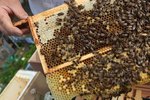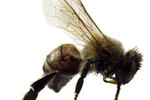
Of the 20,000 or so species of bees in the world, many of them create their own homes to shelter their colonies. Bees design their hives in accordance with their habitat and social structure. Common styles of beehives are underground burrows, hollowed-out trees, open air hives and artificial hives.
Underground Hives
Bumblebees build their hives underground or in debris piles. The queen bee is responsible for finding a nest spot each spring -- she is the only member of her clan that survives the winter. Bumblebees have makeshift homes, anywhere there's a dry, dark, semi-enclosed space they can make their residence. For instance, woodpiles often make good bumblebee nests, or abandoned mice nests. Different bumblebee species will prefer to have their homes above ground, at ground level, or below ground. The queen bee will choose a place that's reasonably dry and will fill it with dry grass or other similar debris to start building the home for her family. Once she lays eggs, they hatch, and the larvae develop, the new colony members get to work completing the hive, collecting honey, and caring for new larvae.
Exposed Hives
Some Asian honeybees build their nests out in the open. They commonly build their hives on structures, like tree branches or cliff overhangs. Apis florea and A. andreniformis are the two Asian dwarf honeybee species that build their nests all the way around small branches and twigs on trees. Giant honeybees build one massive honeycomb that hangs off the bottom of a horizontal structure. In these kinds of hives the bees use their bodies to protect the comb, larvae and queen.
Tree Hives
When not provided with artificial hives, common honeybees most often make their homes in hollow trees. They look for a space that averages about 5 gallons in volume. Bees often smooth the bark around the entrance to their hive, and the inner walls of the tree are covered in plant resin. The bees then line the top and sides of the space with honeycomb. They arrange the hive in the same way each time. At the top is where the honey is stored, in the middle is the bees' food supply, and at the bottom is where the larvae are reared and the queen bee makes her home. Honeybee hives may contain 60,000 colony members.
Artificial Hives
Humans have been making hives for honeybees for thousands of years, and have been thieving their honey for even longer. Bees are one of the first animals humans ever domesticated. In artificial hives, humans provide bees with a cavity that the bees can then fill with honeycomb to build their nests. Artificial hives range from basic clay cylinders to thoughtfully designed Langstroth hives, the most common manmade beehive used today. This hive style was invented by Lorenzo Langstroth in 1851. Part of the reason this hive style became so popular is because the bees don't need to be harmed to extract the honey.
References
- University of Nebraska-Lincoln -- Beekeeping and Apiculture: Honey Bee Swarms
- Princeton University Department of Ecology and Evolutionary Biology: Apidologie 35 (2004) 193–205 -- Collective Control of the Timing and Type of Comb Construction by Honey Bees (Apis mellifera); Pratt, Stephen C.
- Bee Data: The Hollow Tree Experiment
- Asian Honey Bees: Biology, Conservation, and Human Interactions; Benjamin P. Oldroyd and Siriwat Wongsiri
- Beehives; Jill Kalz, Jill Weingartz
- The Quest for the Perfect Hive; Gene Kritsky
- Bumblebee.org: Bumblebee Nest Boxes and Nest Sites
Resources
Photo Credits
-
Comstock/Comstock/Getty Images
Writer Bio
Madeline Masters works as a dog walker and professional writer. In the past she has worked as a fitness columnist, fundraising copywriter and news reporter. Masters won two Pennsylvania Newspaper Association Awards in 2009. She graduated from Elizabethtown College with a Bachelor of Arts in English.



